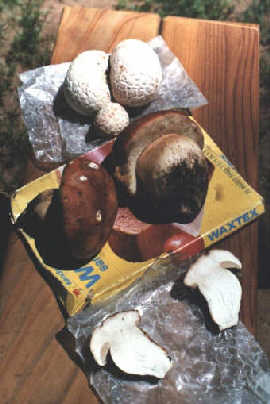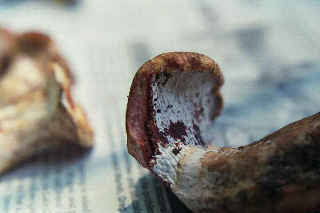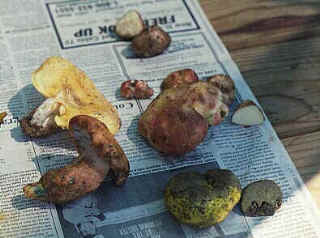|
Comment
This issue is rather late because,
frankly, there was little to report. The lack of rain all year resulted
in the usual lack of fungi. Because of my lack of success, I had to borrow
much information from Mike Wood -- thanks Mike.
There were a few highlights
during the year
though which included a one-week class I took at the Yuba Pass field
campus of the University of San Francisco named Spring Fungi of the
Sierra Nevada (discussed below), the finding of a solitary
Boletus barrowsii, a mushroom foray with the Mycological Society of
San Francisco (MSSF) (discussed later in this issue), and my finally being
able to meet, in person,
several of those with whom I had only corresponded via email.
Spring Fungi of the Sierra Nevada Class
(top)
In the first week of June, after having
discussed the course for several months with several of those who
had previously attended it, I signed up for and went to a one-week
course in Sierra Spring Fungi at the Yuba Pass field campus of
the University of San Francisco.
To see the complete version of this
report complete with many pictures, go to: sierra_fungi.htm
As far as finding fungi during the rest of the year, the
following findings are excerpts taken from my mushroom-log email messages:
Findings,
June to October, 1999
(top)
Saturday, June 12:
I got back from
the fungi class on Friday afternoon. In the class, I learned much and
made a few new friends. My thanks to Mike Wood, Fred Stevens, Steve
Trudell, and Mike Boom, all for encouraging me to take the class.
Today I took a nature hike sponsored by
the Lake Almanor chapter of the Audubon Society. On the walk, I
actually found a few mushrooms (I brought my little basket just
in case). In the first few feet of the trail, I found what will
probably key out to be the White King Bolete, the B. barrowsii.
It was all white, very firm, and the pores were very compact.
It was also very young. I think it is a barrowsii.
I also found 7 morels (Morchella elata)
and a nice specimen of the Yellow Coral Mushroom (probably a
Ramaria rasilispora). After trying out the key on the barrowsii,
I'm going to cook all of them up!
Now I know how to better use the microscope, thanks to the class experience.
Thursday, June 17:
Today, encouraged by my find
of the white Boletus, I went to check out an area above Chester. I was looking for the
yellow Butter Bolete, the Boletus abieticola, as I had found
one there four Julys ago. I found what I thought were they - a
small group of 3. Nearby were 3 sculptured puffballs, I think the
Calvatia sculpta, and a few patches of the Yellow Coral Mushroom,
the Ramaria rasilispora.

Boletes and Puffballs
|
I only gathered the boletes and the
puffballs.
I then went to another campground where I found what looked like evidence of
the B. abieticola: either cut or chewed-off yellow bases, no
full-sized ones, but lots more of the R. rasilispora.
When I got home, I sliced open the
boletes I got from the first area, and now they look more like the B.
pinophilus - too white for the B. abieticola.
I'm not sure what the other boletes were, but the cut off bases were definitely yellow,
about 3-in. in diameter, and very firm. Next time I'll dig out
the bases.
Thursday, July 1:
Went out this morning
to find a lake we saw on a map, north of here. We were able to find the little lake pretty
easily. I didn't really expect to find any mushrooms, but I found
one morel near a fire pit, and after my showing a young boy what
they looked like, he found two more for me! I later found two
nice puffballs (C. sculpta). I am always surprised when I find
anything in the summer, especially after all the hot, dry weather
we have been having.
Finding them all was nice, but finding
the beautiful lake was better.
Tuesday, August 31:
Today we took
a nice walk. Because this year
has been so dry, I didn't bring my mushroom basket, not did
I concentrate on looking at the ground very much.
After a spell, I noticed a couple
of Russulas, which were fairly dry. I thought this was a fluke,
but as I continued, I noticed more mounds, all with fresh Russulas
with a white cap.
Further along the trail, I found
what looked like a Suillus, then later a red-pored Bolete,
and just before we got back to the car, I noticed an odd-looking
mushroom on the side of the trail. After pulling it out to
look at the gills, I discovered it to be a young clump of
young White Chanterelles.
Excited by this discovery,
I looked around the immediate area and found another clump!
MY FAVORITES!
They tasted great that evening!
I can only imagine that the few drops
of rain we've had in the last two weeks must have done some good.
I had already found some Marasmius oreades in our lawn, but
noticed none in the other lawns in the area. Their presence seemed
to coincide with the timing of the rain.
I think I will take a walk today!
Thursday, September 2: I went for a walk
down the same trail we took Tuesday. I didn't find more Chanterelles,
nor was I able to find the spot where I had found them Tuesday, but
I did find much more than I expected. What I did find was:
- a white Russula that bruised brown,
- a gray-capped Russula,
- a pink-capped Russula with yellowing gills,
- a yellowish zoned-cap Lactarius with yellow non-staining latex,
- many Gomphidius glutinosus,
- some Gomphus floccosus,
- a few old Calvatia sculpta, 4 - 6" in diameter,
- and two types of tubers and a polypore.
The tubers were irregularly shaped,
smooth, and both had fairly solid interiors with smooth elliptical
spores. One type was white when picked and soon stained reddish,
with cream-colored interior, the other had a yellow exterior
with gray interior with a small bit of whitish marbling. Both
had small folds in the interior when I looked at them under a
field glass.
The polypore was probably an Albatrellus, but didn't fit any of those listed in David's
book. This one had a reddish cap with
lighter-colored stalk, white minute-sized pores that
immediately stained dark red and gave off a small bit of
red latex, and there were slight signs of green, but it
didn't stain green. When it was cut in half, the edges
of the flesh nearest to the pore surface exuded red latex
too. The flesh was whitish-pink with reddish edges. The flesh
was a bit granular, like an old Lactarius deliciosus. The
spores, if they were spores, were round and slightly knobbed.
I don't have my cover slides yet, so I just put a smear from
the pore surface on a slide and looked at it at 200X.

Close-up
of the "polypore"

Overall View
|
Tuesday, August 17:
On the right is a close-up
of the polypore I found recently
but couldn't identify. I had cut off a bit of the cap to
show the reddish flesh.
With the red-staining pore surface
and the flesh that gave
off a slight bit of red latex when cut, I thought would be
an easy one to find in Arora's book.
Below the close-up is an overall picture of it, along with a Lactarius and two of
the tubers showing the interiors.
I later learned from Mike Boom
that it could have been, and
most likely was, a Lactarius rubrilacteus, parasitized by a Hypomyces.
UPDATE: In 2004, I was told by Bill Neill, Boston Mycological Club, that the
Hypomyces was most likely a Hypomyces lateritius.
With help from Steve Trudell (University of WA),
the tubers turned out to be Rhizopogons, the reddish one
probably a R. rubescens and the yellowish one probably a
R. ochraceorubens.
Saturday, September 18:
I went north up the
highway and tried to find another sample of the Strobilomyces
floccopus that I had found 2 years ago. No such luck. I did
find some beautiful Lepiota naucina (Woman on a Motorcycle).
I plan to cook and try some out tonight (carefully, of course).
They sure looked like a white-gilled Agaricus!
Monday, October 18:
Monday, we took
a friend visiting from Idaho for a walk outside of town, and I decided to show him, Bjarne Larsen who had lived
in Santa Barbara before, where I found some White Chanterelles (Cantharellus
subalbidus) last fall. He used to find the
golden ones (C. cibarius) on his property when he lived in
Santa Barbara.
Just after we got on the path,
Cecelia actually found a good-sized White Chanterelle, a
little darker around the edges, but still firm. I couldn't
believe it because of the lack of rain this year, but there
it was! We proceeded down the path to the place where we had
found most of them last fall, and she found a small clump
of them, not very big, but big enough. No more chanterelles
for that day.
Later we found a very good (firm
and fleshy) example of a Deer Mushroom (Pluteus cervinus)
growing out of a small cavity in a conifer stump, and
another mushroom too small and featureless for me to
identify.
We cooked up the chanterelles
for a tasty sample, and I inadvertently left them over the
fire too long. Most were pretty brown. I discovered that
they even taste good when overcooked!
A few days later, I returned
to the same area to see if I could find more of the morsels.
This time I went to another
previously lucky spot where I had found one last fall under
a piece of bark. I lifted all the bark around the area and
found one! Because I was close enough to the ground to
be able see better (one eye was still pretty blurry), I
spotted a crack in the duff and dug up two more. Not
too bad considering!
This gave me a good chance
to look at the horned cystidia on the Pluteus (using my
new microscope), and they did look very much like the
pictures from Dr. Largent's book, How to Identify Mushrooms
to Genus III, Microscopic Features.
MSSF Foray
(top)
On Saturday, October 9th, Cecelia
and I went to Yuba Pass to join the Mycological Society of San
Francisco on their first mushroom foray of the season. I didn't
expect to find much because of the lack of rain, but needed to get
out and to hopefully meet a few of those members I only knew via
e-mail. We weren't disappointed in the least!
We finally got to meet Mike Boom and Mike Wood in person, (and many
other MSSF members) and got to see Fred Stevens and Norm Andresen again.
The following is a description of the event by Mike Wood:
A group of about a dozen people
collected around seventy-five species of fungi. The area was
generally dry, but collecting was interesting in the seepage
areas at Chapman Creek Campground and on Wardzinska ridge (on
the road to Webber Lake from Yuba Pass).....The Sierras are
beautiful in the fall and this weekend was especially nice.
Bright blue skies in the day and nights filled with stars. I
always enjoy the fall Yuba Pass forays, lots of interesting
mushrooms are usually found. Among the most interesting collections
were Gastroboletus turbinatus, Macrocystidia cucumis,
Thaxterogaster pingue, and a Sarcodon we have not been able
to name. The best edible found were Russula xerampelina and
Rozites caperata. The culinary highlight of the weekend, from
a mycophagists point of view, was the Russula xerampelina
tempura...DELICIOUS! --Mike Wood
The mushroom pictures
on the right are two of the mushrooms Cecelia and I collected, both
taken by Mike Wood. The one on the top is a Rozites caperata, the
one on the bottom, a Thaxteogaster pinque. Again from Mike:
Here is the final species
list from the Yuba Pass foray. This includes all the
collections from the MSSF group and the collections from
Dennis Desjardin and his class. Albatrellus ellisii, Albatrellus
sp. flettii, Aleuria aurantia, Amanita gemmata, Amylocystis lapponica,
Armillaria gallica, Bisporella citrina, Boletus calopus, Boletus haemitinus, Boletus zelleri, Calvatia
subcretacea, Cantharellus subalbidus, Chlorociboria aeruginascens, Chroogomphus
rutilans,
Chroogomphus sp., Chrysomphalina (Omphalina) luteicolor,
Clavulina cinerea, Clitocybe clavipes, Coltrica perennis,
Cortinarius alboviolaceus, Cortinarius spp, Cryptoporus volvatus,
Cryptoporus volvatus, Cystoderma fallax, Dacrymyces sp.,
Dasyscyphus bicolor, Echinodontium tinctorium, Endotychum depressum,
Fomitopsis pinicola, Galerina spp., Gandoderma applanatum, Gandoderma oregonense, Ganoderma applanatum, Ganoderma
tsugi,
Gastroboletus turbinatus, Geopora cooperi, Geopyxis carbonaria,
Godronia sp., Gomphus bonarii, Gyromitra infula, Hebeloma spp.,
Helvella lacunosa, Helvella leucomelaena, Heterobasidion annosum,
Heterotextus alpinus, Hohenbuehelia petaloides, Hyaloscypha sp.,
Hygrocybe conica, Hygrophoropsis aurantiaca, Hygrophorus hypothejus,
Hygrophorus purpurascens, Hypholoma capnoides, Hypholoma fasciculare,
Hypsizygus tessellatus, Inocybe spp., Laccaria laccata, Laccaria montana,
Lachnellula arida, Lactarius deliciosus, Lactarius luculentus,
Lactarius pallascens, Lactarius scrobiculatus, Leptoporus mollis,
Lycoperdon perlatum, Macowanites sp., Macrocystidia cucumis,
Melanoleuca graminicola, Melanoleuca melaleuca, Mycena alkaliniformis,
Mycena amicta, Mycena citrinomarginata, Mycena galericulata, Mycena pura
Mycena sp., Naucoria escharoides, Naucoria scolecina, Oligoporus leucospongia, Phaeolus
schweinitzii, Phellinus sp., Pholiota aurivella,
Pholiota flammans, Pholiota flavida, Pluteus cervinus, Pluteus petasatus,
Polyporus badius, Polyporus elegans, Polyporus melanopus, Polyporus sp.,
Psilocybe montana, Pyrenogaster (Radiigera) atrogleba, Ramaria formosa,
Ramaria rasilispora, Ramaria spp., Rhizopogon ellenae,
Rhizopogon ochraceorubescens, Rhizopogon sp., Rhodocollybia maculata,
Rozites caperata, Russula adusta, Russula aff. cremicolor,
Russula albonigra, Russula alutacea, Russula atrata, Russula brevipes,
Russula brevipes var. brevipes, Russula brevipes var. acrior,
Russula densifolia, Russula dissimulans, Russula murrillii,
Russula mustelina, Russula semirubra,
Russula simillima, Russula sp., Russula stuntzii, Russula xerampelina,
Sarcodon sp., Scutellinia scutellata, Sedecula pulvinata, Stereum sp.,
Strobilurus albipilatus, Suillus albidipes, Suillus brevipes,
Suillus punctatipes, Suillus sibiricus, Suillus sp., Suillus tomentosus,
Suillus umbonatus, Thaxterogaster pingue, Thelephora terrestris,
Trichaptum abietinum, Tricholoma atroviolaceum, Tricholoma portentosum,
Tricholoma saponaceum, Tricholoma sp., Tricholomopsis rutilans,
Vesiculomyces citrinus, Xeromphalina cauticinalis, Xeromphalina kauffmanii. Not bad, 140 species in a dry
year! --Mike Wood
Mushroom Tempura
(From an email message from Michael Wood) (top)
Greetings - As many of you
know, one of my favorite ways to eat mushrooms is in the form
of Tempura. Last night I cooked two of the species that I have
only tried a couple of times before. This was the first time
I had tried these as Tempura. The two species were Rozites caperatus and Suillus
tomentosus. The Rozites had a mild flavor
and a good texture, the cap being more interesting than the
stipe. I had sautéed some of the Rozites in butter the previous
evening. The Rozites Tempura was better. The Suillus tomentosus
had a stronger flavor and was quite nice, rather nutty. The
texture was creamy in the Tempura. A usual complaint about
Suillus is that the texture is too soft, but it worked very
well as Tempura, the creamy texture a nice complement to the
crispy coating. I have dried the rest of the S. tomentosus
collection, as I suspect it will be good dried. Both of these
were good as Tempura...not as good as the great Russula
xerampelina Tempura we cooked up at Yuba Pass...or my favorite,
Agaricus augustus Tempura, but a nice meal. And both of these
are much better this way than sautéed in butter. Like I always
say...if you don't like an edible one way...try it another
way. --Mike Wood
Featured Mushroom,
Chroogomphus vinicolor (Pine Spike) (top)
This mushroom can be very
plentiful at times, is edible, but is often overlooked. It
is mainly associated with pine and can be found during most
of the year. I found that drying them was a
good way to store them for later use for using in a spaghetti sauce.
This mushroom adds both a nice texture and color to the sauce. Another way
I like to use them is pickled with other mushrooms (see recipe in
the Fungi-zette Issue #3). The texture, when prepared in this manner,
is very much like the commercially grown and harvested white button
mushrooms. It's worth a try!
Here is the link to the
mushroom on the Mykoweb website:
Chroogomphus vinicolor
Back to HOMEPAGE
|